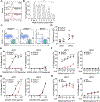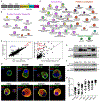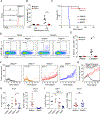WDFY4 is required for cross-presentation in response to viral and tumor antigens
- PMID: 30409884
- PMCID: PMC6655551
- DOI: 10.1126/science.aat5030
WDFY4 is required for cross-presentation in response to viral and tumor antigens
Abstract
During the process of cross-presentation, viral or tumor-derived antigens are presented to CD8+ T cells by Batf3-dependent CD8α+/XCR1+ classical dendritic cells (cDC1s). We designed a functional CRISPR screen for previously unknown regulators of cross-presentation, and identified the BEACH domain-containing protein WDFY4 as essential for cross-presentation of cell-associated antigens by cDC1s in mice. However, WDFY4 was not required for major histocompatibility complex class II presentation, nor for cross-presentation by monocyte-derived dendritic cells. In contrast to Batf3 -/- mice, Wdfy4 -/- mice displayed normal lymphoid and nonlymphoid cDC1 populations that produce interleukin-12 and protect against Toxoplasma gondii infection. However, similar to Batf3 -/- mice, Wdfy4 -/- mice failed to prime virus-specific CD8+ T cells in vivo or induce tumor rejection, revealing a critical role for cross-presentation in antiviral and antitumor immunity.
Copyright © 2018 The Authors, some rights reserved; exclusive licensee American Association for the Advancement of Science. No claim to original U.S. Government Works.
Figures




Comment in
-
A key ingredient for priming killer T cells.Science. 2018 Nov 9;362(6415):641-642. doi: 10.1126/science.aav3683. Science. 2018. PMID: 30409872 No abstract available.
References
-
- Crozat K, Tamoutounour S, Vu Manh TP, Fossum E, Luche H, Ardouin L, Guilliams M, Azukizawa H, Bogen B, Malissen B, Henri S, Dalod M, Cutting edge: expression of XCR1 defines mouse lymphoid-tissue resident and migratory dendritic cells of the CD8alpha+ type J.Immunol. 187, 4411–4415 (2011). - PubMed
Publication types
MeSH terms
Substances
Grants and funding
- T32 CA009621/CA/NCI NIH HHS/United States
- P30 AR073752/AR/NIAMS NIH HHS/United States
- F30 DK108498/DK/NIDDK NIH HHS/United States
- R01 CA193318/CA/NCI NIH HHS/United States
- T32 AI007163/AI/NIAID NIH HHS/United States
- HHMI/Howard Hughes Medical Institute/United States
- U19 AI109948/AI/NIAID NIH HHS/United States
- P30 CA091842/CA/NCI NIH HHS/United States
- P30 DK020579/DK/NIDDK NIH HHS/United States
- U42 OD011185/OD/NIH HHS/United States
- U19 AI109725/AI/NIAID NIH HHS/United States
- R01 CA190700/CA/NCI NIH HHS/United States
LinkOut - more resources
Full Text Sources
Other Literature Sources
Molecular Biology Databases
Research Materials

